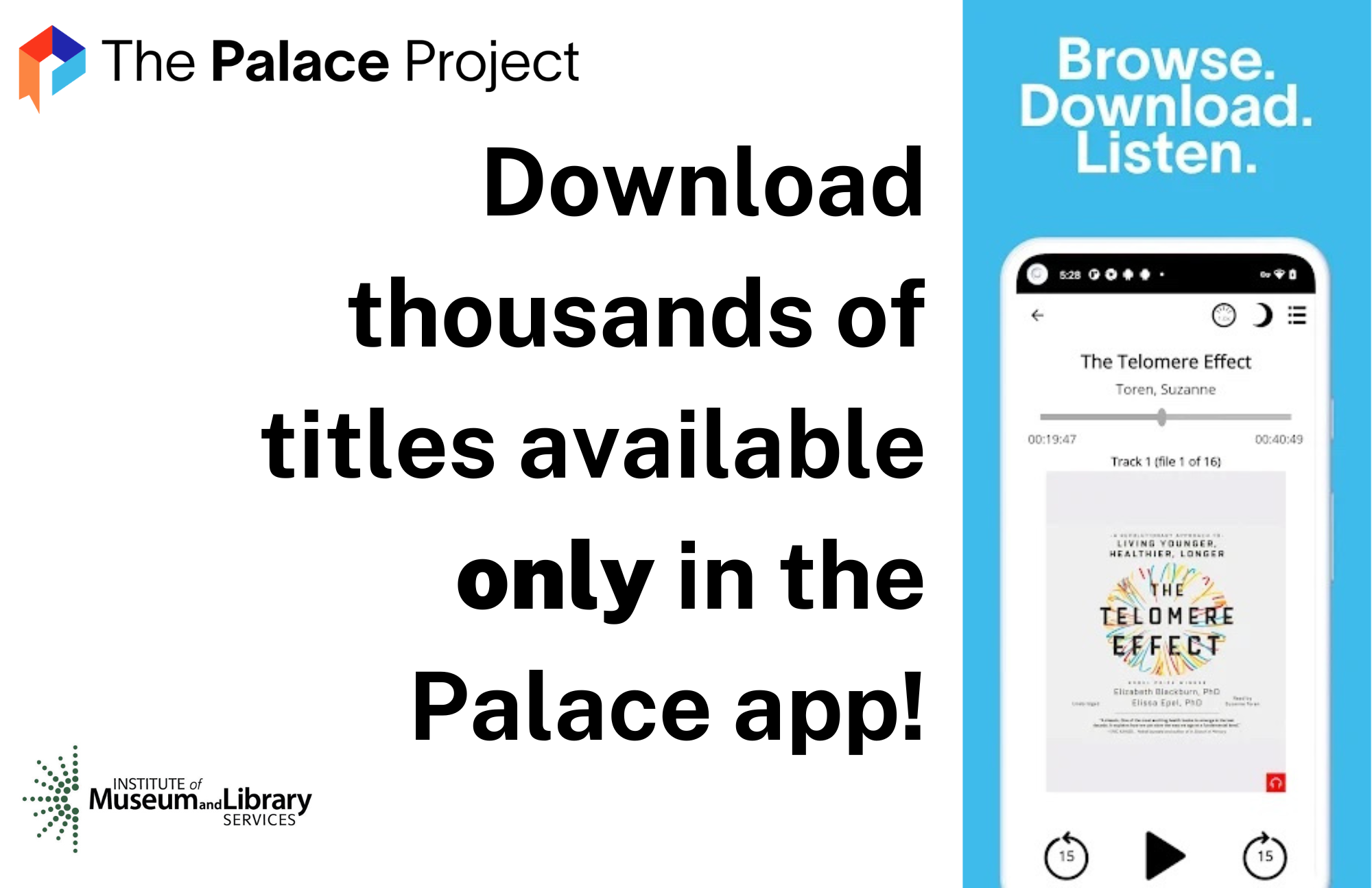

In 2020, Lyrasis received an IMLS grant to develop and pilot an ebook and audiobook service for state and public libraries. The Palace Project deploys a cloud-based, remotely supported digital library reading platform for collection management and provides a curated set of ebooks and audiobooks through the Palace app and Virtual Library Card that allows immediate patron access. During the grant period of September 2020 through February 2024, Lyrasis developed and tested service components, piloted the service for 17 months with pilot libraries, provided training and support for library staff and their patrons, and assessed value and impact for libraries and patrons. Pilot libraries each received $25,000 of digital content.
The success of the grant ensures that Palace Project provides a national model for a unified, patron-centric, library-driven ebook and audiobook system that uses the power of public library collaboration to deliver more and diverse content.
In this post, we will discuss feature developments that began with the grant project and continue, the library and patron adoption efforts that were undertaken during the project, and the benefits of working with state libraries to promote and support The Palace Project.
Analytics and Reports
The new analytics platform took a lot of time and effort to design and develop, and went through several iterations before an initial implementation was ready to deliver to libraries. This initial implementation is only a starting point; the platform has been architected so that updates to the reports can be done with low to moderate involvement from the software engineering team. This has allowed our liaison group, the Partner Success team, to take on the task of managing and updating the reports in Amazon QuickSight, only involving the software engineering team when updated reports need to be deployed to libraries in production. The Partner Success team has been sharing the reports with a small group of stakeholders and making changes based on feedback to ensure the reports are as useful as possible ahead of the production launch.
In tandem with these efforts, the engineering team has been developing a new inventory report service that will allow Palace Manager users to click a button to request a report that includes license and hold counts for all titles in their collections, except for those from integrations with third-party distributors. (In those cases, such reports are available directly from the distributors.) This report complements the data from the analytics platform because it is a snapshot of a point in time rather than a report based on a configurable time period. The inventory report shows a library what it has in its collection right now; the analytics dashboard shows a library what circulation activity happened over a specific period of time. Together, these tools provide a wealth of information that libraries can use to better understand how their collections are being used and how they can continue to improve them.
Early in the grant project, Licensed Content Protection (LCP) Digital Rights Management (DRM) was integrated into the Palace mobile apps. This technology was described in the first blog post in this series, and it continues to evolve over time. One of the current issues with LCP is that the complete archive (ZIP) file for a book must be downloaded before it can be opened and read or played. This is not a major issue for ebooks because the file (the EPUB) is generally small and can be downloaded and opened quickly. Audiobooks are typically much larger and can take a lot longer to download, especially over a slow internet connection. This shortcoming is being addressed in the new versions of the LCP toolkits for iOS and Android, which are anticipated to be released this year. As these new toolkits are released, the Palace engineering team will work to update the Palace mobile apps with the latest features and functionality, including the new capability to start playing an audiobook before the entire ZIP archive has been downloaded to the device.
Library and Patron Adoption
Throughout the grant period, the Palace team assisted libraries with their staff and patron adoption efforts by implementing strategies focused around the creation and refinement of promotional materials and outreach collateral, facilitating quarterly meetings and numerous trainings, and encouraging libraries to host their own patron end user groups.
Marketing and promotional materials were initially developed by Palace staff members and provided in the Dropbox folder known to the group as the IMLS Toolkit. Over the course of the grant period, the team continued to update and expand the items available to libraries.
Materials in the IMLS Toolkit:
- Flyers, templates, and printable takeaway Items
- Instructional videos in English and Spanish
- Marketing language for the web
- Palace talking points
- Instructional documentation on the Palace Collection Manager, Palace app, Virtual Library Card, Virtual Library Card backend portal, purchasing content, and how to demo the app
- Demonstration scripts
- Library reference sheets for troubleshooting
- Virtual Library Card documentation
- Checklist for all materials
- Palace logos and digital resources
- Social media graphics
- QR code cards
Digital marketing materials included seasonal and event themed social media graphics. We also offered just Palace logos for libraries to add to their own collateral, and Palace social media templates that could be personalized by the library.
Promotional collateral was created to facilitate library promotion of Palace. Printable flyers, postcards and bookmarks were provided initially and expanded over the course of the grant period. After receiving feedback requesting physical items, we created the Palace QR code card and bookmark to share with libraries.
The Palace team provided extensive outreach to libraries through multiple trainings and meetings with library staff to offer support and reassurance throughout the process. Additionally, structured quarterly meetings were held for the group to facilitate brainstorming sessions, feedback discussions and troubleshooting. Beyond the large number of meetings, Palace also hosted representatives from each of the participating libraries at ALA 2023 for an event where each library presented on their experience with Palace.
Training videos were created due to the high demand for training for both staff members and library patrons. The Palace team worked with an instructional designer at an elearning company to create and produce professional videos, in both English and Spanish, to cover the most important and requested topics. These videos continue to provide support for all of the Palace libraries.
Training documentation was written and continually updated by Palace staff as features changed within the app. All materials were shared within the IMLS Toolkit and on our closed social media community hub for participating libraries. Topics included in the training documentation focused on various aspects of using the Palace Collection Manager, the Palace app, the VLC and VLC backend portal, and purchasing from BiblioBoard and the Palace Marketplace.
Our social media community for Palace libraries, known as "The Community Hub," served as a valuable resource for library staff to connect, share experiences and discuss Palace-related matters. This platform also allowed Palace personnel to provide support by answering questions and assisting with troubleshooting alongside staff from various libraries in the group. Additionally, the Palace team used the Hub to share information about meetings, training sessions and new materials for the IMLS toolkit. This space proved to be an effective tool for engagement outside of scheduled meetings, fostering camaraderie among the participating libraries.
The Palace team has used the feedback received throughout the grant project to inform our patron and library adoption and engagement efforts going forward.

The Palace Project postcard from the IMLS toolkit.
Working with State Libraries
Two state libraries took part in the Palace Project IMLS grant, highlighting the significant value of partnerships with state library stakeholders in advocating for Palace. State libraries are uniquely positioned to recommend the Palace app to libraries statewide, rather than just at a single location. By advertising their involvement with Palace, state libraries accelerated the spread of information about the app, reaching a larger audience than local libraries.
The participating state libraries experienced greater success in adoption and usage of the app compared to individual libraries, as indicated by their usage data. They achieved the highest number of both users and checkouts among all the participating grant libraries. State libraries benefit from courier systems, which facilitate easy distribution of materials across the state. Additionally, their social media channels have a broader reach, allowing them to share messages more efficiently and widely within their communities.
Furthermore, state libraries have employees that are not required to staff reference desks, giving them more free time to assist with training and troubleshooting for their libraries.
Overall, working with state libraries greatly benefitted the libraries in their respective states because of the additional resources available to promote adoption and engagement with the app for library staff members and patrons.
This concludes our series of posts highlighting the takeaways from the IMLS grant project. If you missed them, here is the first post, Developing the App with Pilot Libraries, and the second, Access for All.
The Palace team is continuing to improve and refine its platforms based on the outcomes of the grant project. If you have any questions about the project, or are curious about using Palace for your library, please reach out to info@thepalaceproject.org.
